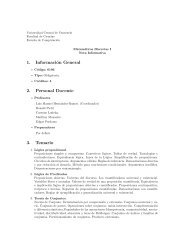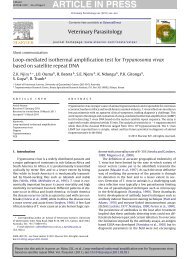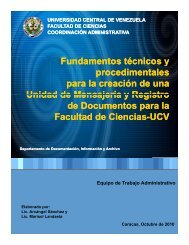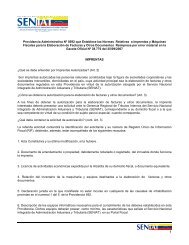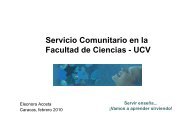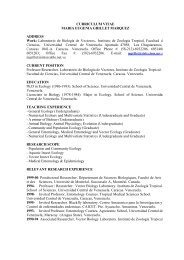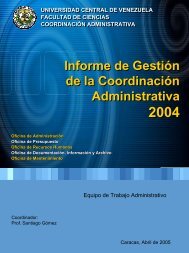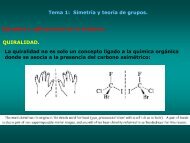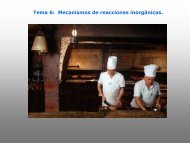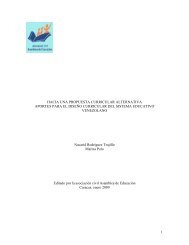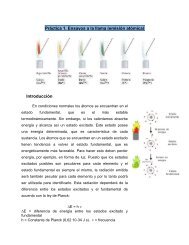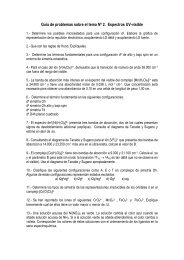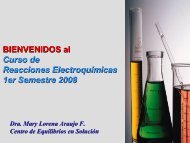Collecting and Preserving
Collecting and Preserving
Collecting and Preserving
- No tags were found...
You also want an ePaper? Increase the reach of your titles
YUMPU automatically turns print PDFs into web optimized ePapers that Google loves.
Techniques <strong>and</strong> ToolsHeathcote 1957; Houseweart et al. 1979; Joosse 1975;Loschiavo 1974; Luff 1968, 1975; Masner & Huggert1979; Morrill 1975 (bibliography); Muma 1975;Newton & Peck 1975; Reeves 1980; Schmid et al.1973; Shubeck 1976; Smith 1976; Smith et al. 1977;Thomas & Sleeper 1977; Tretzel 1955; Van den Berghe1992; Welch 1964.1.10.6 Moericke Traps <strong>and</strong> Other Color TrapsMoericke traps or yellow pan traps are usedextensively by some collectors. An aluminum or plasticpan is painted yellow <strong>and</strong> placed on the ground (or adepression may be dug <strong>and</strong> the pan set in the depression)<strong>and</strong> filled about 1/3 full with salt water, or someother non-toxic fluid. A few drops of detergent of someother surfactant is added to the water to break thesurface tension. Insects attracted to the pan fall into thefluid <strong>and</strong> perish. The trap is then strained periodically(one favorite strainer is a small aquarium fish net). Pantraps such as this, are often placed under malaise traps<strong>and</strong> flight interception traps to catch insects that may hitthe trap <strong>and</strong> fall to the ground.Yellow seems to be the best color for traps, butvarious kinds of insects react differently to differentcolors. Some recent research indicates that certain parasiticwasps respond most strongly to blue.Fig. 12. Emergence <strong>and</strong> rearing traps.with a rim, set in the earth (fig. 11) <strong>and</strong> partly filled with70 percent ethanol, or, if available, with ethylene glycol,which does not evaporate. A piece of stout wire, such as acoathanger, is bent as shown, with a loop at one end tohold the bait receptacle. A few zigzag bends in the otherend of the wire will keep the looped end from swingingafter the wire is pushed into the earth. The bait receptaclemay be a small plastic or metal cup such as is often usedfor medicine doses, or a coffee creamer, or a cup formedfrom aluminum foil. When baited with animal or humanfeces, this trap attracts beetles, mostly of the familiesScarabaeidae <strong>and</strong> Staphylinidae, springtails, ants, earwigs,some parasitic Hymenoptera, <strong>and</strong>, rather surprisingly,several families of flies, especially Phoridae, Sepsidae, <strong>and</strong>Muscidae. The larger, strong-flying calliphorid <strong>and</strong>sarcophagid flies seldom fall into the liquid, although theyare attracted to the bait. The alcohol fumes probably causethe smaller flies to drop into it. The trap is made of easilyobtained materials, is easily transported, <strong>and</strong> providesexcellent results. It deserves wide use.References: Adlerz 1971; Barber 1931; Beaudry1954; Briggs 1971; Clark <strong>and</strong> Blom 1992; Dethier 1955;Fichter 1941; Gist & Crossley 1973; Golding 1941;Greenslade 1973; Greenslade & Greenslade 1971;Greenslade 1964; Gressitt et al. 1961; Grigarick 1959;Colored sticky traps are also used to sample insectsin various habitats. One of these, the Manitoba trap (fig.15) has a black sphere to attract horse flies (familyTabanidae), which are then captured in a canopy-type trap.References: Beroza 1972; Granger 1970; Gurney et al.1964; Hottes 1951; Kieckhefer et al. 1976; Kring 1970;Marshall, 1994; Moericke 1951, 1955 (in german);Prokopy 1973; Weseloh, 1986.1.10.7 Emergence <strong>and</strong> Rearing TrapsAn emergence trap is any device that prevents adultinsects from dispersing when they emerge from theirimmature stages in any substrate, such as soil, plant tissue,or water. A simple canopy over an area of soil, over a plantinfested with larvae, or over a section of stream or otherwater area containing immature stages of midges, mayflies,<strong>and</strong> other arthropods will secure the emerging adults.If it is equipped with a retaining device, as in the Malaisetrap, the adults can be killed <strong>and</strong> preserved shortly afteremergence. It must be remembered, however, that manyinsects should not be killed too soon after emergencebecause the adults are often teneral or soft bodied <strong>and</strong>incompletely pigmented <strong>and</strong> must be kept alive until thebody <strong>and</strong> wings completely harden <strong>and</strong> colors developfully. Emergence traps <strong>and</strong> rearing cages (fig. 12) enable15



